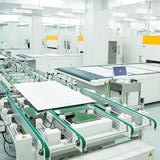

In the process of screen printing, we have to clean the dirt on the screen from time to time. Today we will look at how to flush the screen after exposing the screen printing screen.
When using a flat screen printer, stop the printer after printing a set of sheets, and then input a piece of blotting paper to bring the screen into contact with the blotter. Let the screen be in the printing position, then wipe off the dirt on the stencil surface with a non-abrasive soft cloth with a screen cleaner. Don't use too much force, so the dirt will fall through the mesh. On the absorbent paper below, if necessary, repeat the cleaning of the mesh with a piece of absorbent paper.
Some of the dirt particles that fall on the top may be too large to pass through the mesh, but they can be glued with a soft cloth. After cleaning, the template can be blown dry with a blower (call "cold air"). Sometimes the dirt under the template is removed. In this case, the dirt should be gently wiped off with a soft cloth. Do not use excessive force. In addition to doing these things, we should also pay attention to the following points in our usual work.
First, first prepare for anti-fouling. When printing high-net color images, the emulsifier film under the wire is only 5-6um thick, and the mesh diameter of the mesh itself may be only 30um, which cannot withstand friction. Therefore, the key to avoiding rough decontamination is to prevent the stencil from being contaminated first.
Second: The main reason for the pollution of the template is the improper control of the ink, which causes the dry ink to remain in the mesh. When a solvent-based ink or an aqueous ink is used, the reason is that the ink is too thin or too thick. It should not change in the state of ink adjustment. When using UV-curable inks, efforts should be made to avoid exposure of the screen to UV light and to avoid sun exposure.
Another problem with ink control and improper adjustment of printing speed can result in uneven supply and rapid drying of the ink-receiving mesh. The latter reason for causing the ink to dry out is that the squeegee is improperly set or worn. When printing a fine image with a high number of screen lines, it is required to use the squeegee edge to deform or be worn during normal use, and the image is clear. The degree of decline is also reduced, which indicates that the ink may not pass through the mesh normally. If this problem is not solved in time, the ink will dry in the mesh. To avoid these problems, the squeegee should be flipped periodically to extend the life of its squeegee, or to switch to a new squeegee before the print quality has dropped.
Third: In order to make the mesh function properly, you should also pay attention to cleaning the dirt in the ink or on the substrate. Due to the electrostatic adsorption of pollutants in the air and poor storage conditions, the surface of the substrate may be contaminated. The above problems can be solved by improving storage conditions and process control. In addition, the destaticizer and the substrate decontamination device can be used. Prevent dust and dirt from transferring from the printing surface into the mesh.
Tel:15158365810
HTML:www.mysyqc.com
Add:No.185, bridge 3 road, xiaoqiaotou village, qiaotou town, cixi city